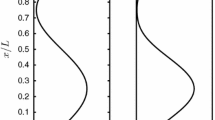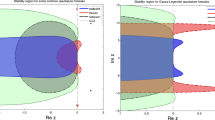Abstract
A number of authors have reported the problem of unrealistic velocities (“rogue trajectories”) when computing the paths of particles in a turbulent flow using modern Lagrangian stochastic (LS) models, and have resorted to ad hoc interventions. We suggest that this problem stems from two causes: (1) unstable modes that are intrinsic to the dynamical system constituted by the generalized Langevin equations, and whose actual triggering (expression) is conditional on the fields of the mean velocity and Reynolds stress tensor and is liable to occur in complex, disturbed flows (which, if computational, will also be imperfect and discontinuous); and, (2) the “stiffness” of the generalized Langevin equations, which implies that the simple stochastic generalization of the Euler scheme usually used to integrate these equations is not sufficient to keep round-off errors under control. These two causes are connected, with the first cause (dynamical instability) exacerbating the second (numerical instability); removing the first cause does not necessarily correct the second, and vice versa. To overcome this problem, we introduce a fractional-step integration scheme that splits the velocity increment into contributions that are linear (U i ) and nonlinear (U i U j ) in the Lagrangian velocity fluctuation vector U, the nonlinear contribution being further split into its diagonal and off-diagonal parts. The linear contribution and the diagonal part of the nonlinear contribution to the solution are computed exactly (analytically) over a finite timestep Δt, allowing any dynamical instabilities in the system to be diagnosed and removed, and circumventing the numerical instability that can potentially result in integrating stiff equations using the commonly applied explicit Euler scheme. We contrast results using this and the primitive Euler integration scheme for computed trajectories in a drastically inhomogeneous urban canopy flow.
Similar content being viewed by others
References
Garfinkel D, Marbach C (1977) Stiff differential equations. Ann Rev Biophy Bioeng 6:525–542
Golub GH, Van Loan CF (1996) Matrix computation, 3rd edn. John Hopkins University Press, Baltimore, MD, 694 pp
Hu C (1999) On the extended one-step schemes for solving stiff systems of ordinary differential equations. Int J Comput Math 70:773–788
Iserles A (1981) Quadrature methods for stiff ordinary differential systems. Math Comput 30:171–182
Kloeden PE, Platen E (1995) Numerical solution of stochastic differential equations. Springer-Verlag, Berlin, 632 pp
Lien F-S, Yee E (2004) Numerical modelling of the turbulent flow developing within and over a 3-D building array, part I: a high-resolution Reynolds-averaged Navier-Stokes approach. Boundary-Layer Meteorol 112:427–466
Luhar AK, Britter RE (1989) A random walk model for dispersion in inhomogeneous turbulence in a convective boundary layer. Atmos Env 23:1911–1924
Moore PK, Petzold LR (1994) Stepsize control strategy for stiff systems of ordinary differential equations. Appl Num Math 15:449–463
Nasland E, Rodean HC, Nasstrom JS (1994) A comparison between two stochastic diffusion models in a complex three-dimensional flow. Boundary-Layer Meteorol 67:369–384
Sawford BL, Guest FM (1988) Uniqueness and universality in lagrangian stochastic models of turbulent dispersion. In: 8th symposium on turbulence and diffusion. American Meteorological Society, Boston, MA, pp 96–99
Thomson DJ (1987) Criteria for the selection of stochastic models of particle trajectories in turbulent flows. J Fluid Mech 180:529–556
Vreman B, Geurts B, Kuerten H (1994) Realizability conditions for the turbulent stress tensor in Large Eddy simulation. J Fluid Mech 278:351–362
Wilson JD, Flesch TK (1993) Flow boundaries in random flight dispersion models: enforcing the well-mixed condition. J Appl Meteorol 32:1695–1707
Wilson JD, Flesch TK, Harper LA (2001) Micro-meteorological methods for estimating surface exchange with a disturbed windflow. Agric For Meteorol 107:207–225
Wilson JD, Yee E (2000) Wind transport in an idealized urban canopy. In: Preprints, 3rd symposium on the urban environment. American Meteorological Society, pp 40–41
Yee E, Biltoft CA (2004) Concentration fluctuation measurements in a plume dispersing through a regular array of obstacles. Boundary-Layer Meteorol 111:363–415
Yee E, Gailis RM, Hill A, Hilderman T, Kiel D (2006) Comparison of wind tunnel and water channel simulations of plume dispersion through a large array of obstacles with a scaled field experiment. Boundary-Layer Meteorol 121, DOI: 10.1007/s10546-006-9084-2, 44 pp
Author information
Authors and Affiliations
Corresponding author
Rights and permissions
About this article
Cite this article
Yee, E., Wilson, J.D. Instability in Lagrangian stochastic trajectory models, and a method for its cure. Boundary-Layer Meteorol 122, 243–261 (2007). https://doi.org/10.1007/s10546-006-9111-3
Received:
Accepted:
Published:
Issue Date:
DOI: https://doi.org/10.1007/s10546-006-9111-3




